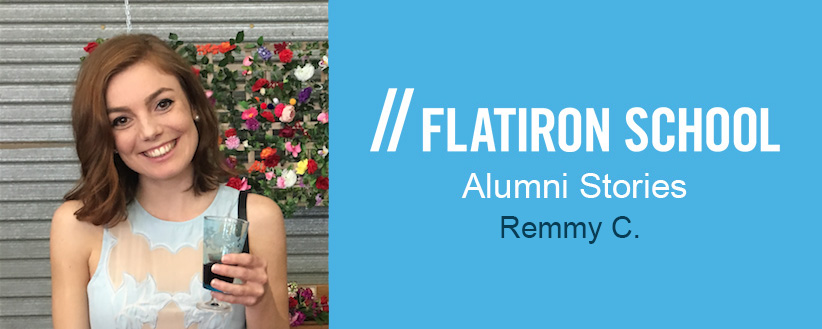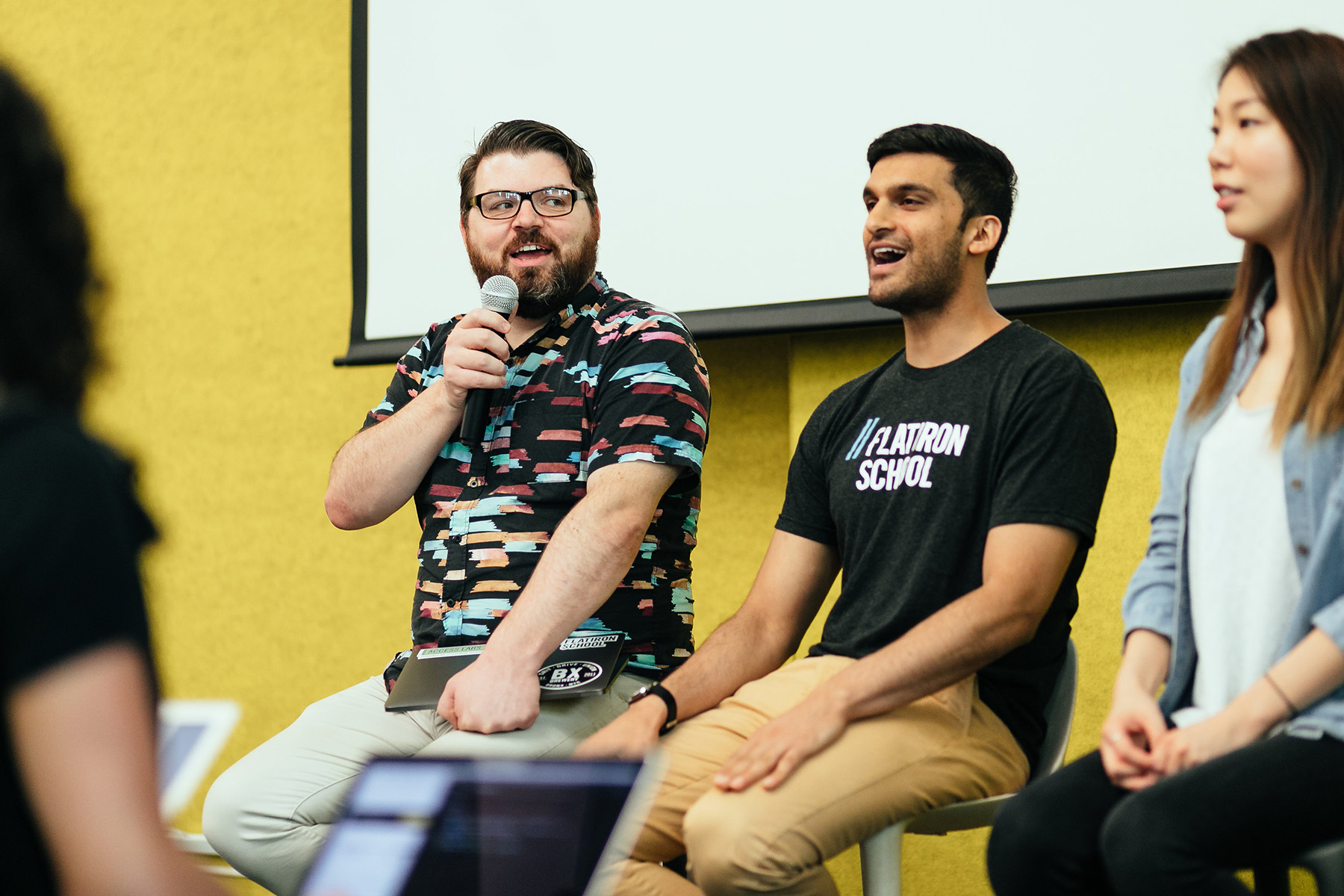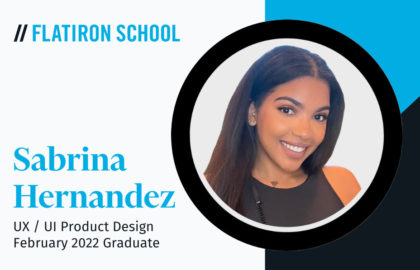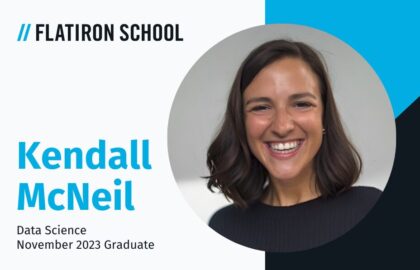At Flatiron School, our success is our students’ success — when students get jobs, we’ve done our job. But, students’ stories don’t end after they graduate. In this series, we chat with members of Flatiron School’s alumni community about their journey into code, and how that journey transformed their life.

Remmy C., one of Flatiron School’s recent graduates, was a commercial litigation attorney for three years, unhappy with her industry’s regressive, change-resistant attitude. She felt the world was progressing forward, and she felt like she was getting left behind. It was clear she needed a change — she wanted to join an industry that was progressing and making a positive impact. After some thinking, it was clear that she wanted to take a step into the future with code, and she shortly thereafter enrolled in Flatiron’s Online Software Engineering Bootcamp, and is now a software engineer at Denver’s Sawatch Labs.
In the interview below, Remmy discusses how she used code to move away from an unfulfilling career to one that embraced her beliefs. Read on to see how her switch emblemizes how it’s possible for anyone hesitant to change careers to do exactly that: change their life.
Switching careers
Remmy was a lawyer in Sydney, Australia. It was a fine enough career, and certainly paid well enough, but she always knew she’d eventually seek out something new. Remmy had ambition, and wanted to be a part of the progress she saw around her and appreciated.
“Law is a very slow industry and very resistant to change,” Remmy said. “There are so many exciting things happening in the world at the moment and the law is saying ‘No, no, no. Ignore all of that.’”
That’s when she decided to she wouldn’t let something she cared about — progress — pass her by, and decided to switch careers. At the time, her partner was working at a startup in Sydney, and she had several friends who were developers. After some deliberation, she decided to pursue her own web development career.
Key Takeaway → Not all careers are created equal. Some careers will be satisfying for a few years, but may not be as adaptable as others. Your priorities and ambitions will change, and that’s fine! If you feel that way, maybe it’s time to reevaluate your current career.
The Flatiron School experience

Remmy’s journey started in a way that’s familiar to all of us — a Google search. She found Flatiron School and quickly felt connected to the bootcamp.
“I had a chat with Michael Krashes [a key member of Flatiron’s Admissions team] and he was really positive and enthusiastic. This was really early in my search, and it stuck with me,” Remmy said.
After the warm impression, Remmy found another reason to enroll at Flatiron School.
“I just loved the bootcamp prep. Not many places give you a chance to try out the platform,” she said. “The Ask-a-Question feature was my favorite thing. I was in Australia at the time, so being able to ask someone something and getting instant feedback was really important to me.”
Having support, especially with something as important as changing careers, is a crucial component for success. In Remmy’s case, it was even more important because she did not have any technical experience before starting Flatiron.
She was able to find the help she needed through Flatiron’s curriculum. “Flatiron School teaches you how to ‘learn how to learn,’ which has been really effective for me. When I’m asked to do something new, I know where to start, and I feel empowered to find the answers,” she said.
Key Takeaway → Support is crucial for change. Finding the right help and culture is vital to a successful transformation. Don’t just choose the “best” bootcamp, choose the right coding bootcamp for you. For Remmy, and for many career changers, the right coding bootcamp must have a strong support system.
Empowering change

“Hard skills,” the tools that are taught to you, are just one part of the equation. “Soft skills,” the intangible tools that make you an effective communicator and great teammate, are another part, and especially important in coding. In software engineering, you don’t only need your code to work, but must also explain how it works across multiple teams, each with varying levels of technical understanding.
“Being able to know what the code is and explaining why it works are two very different things. I was able to talk about my code a lot at Flatiron, and that helped when I had technical interviews,” Remmy said.
“Pair programming [when two developers work together using one computer] was also very enlightening, because you get to speak to people with different backgrounds and levels of experience.”
Toward the end of her course, Remmy was paired with a Career Coach who would work with her to secure a job she wanted.
“Career Services was great. My coach was always available,” Remmy said, adding that it was another great part of Flatiron’s support system.
Remmy was in a unique position because she needed a visa to stay in America. While she wanted a job, she also wanted the right job for her. “I received one offer from another company, but was hoping to get an offer from my current company,” Remmy said. “It was a great problem to have!” Her coach helped explained how she should approach the situation and potential responses to help her make the right decision.
Upon graduation, Remmy received the offer from her preferred employer, Sawatch Labs in Denver. She’s now there, helping companies to operate more efficiently and reduce their carbon footprint.
Key Takeaway → Hard skills and soft skills are necessary for a successful career change. When pursuing a new career, you should learn new skills and new tools to communicate effectively. We at Flatiron School take that very seriously, and tailor our courses to ensure students learn soft skills as well as technical ones.
A career as a software developer
Remmy’s now a full-time software engineer, working at a startup tackling today’s climate problems, which is something Remmy’s passionate about.
“I’m working as a software developer at a startup in Denver helping local and state governments convert their current fleet of vehicles to electric or hybrid vehicles,” Remmy said. “We use telematics to track all the driving of all the vehicles in your fleet and say ‘These are the ones that you should switch to electric vehicles. These are the ones that could be hybrids. This is where you should be your charging infrastructure.’”
Most importantly, she’s doing work that’s equal parts challenging and rewarding. “I love the company,” Remmy said. “It’s full-stack, which is exactly what I wanted to do, and there’s no shortage of work!”
Ready to start your own career change? Learn more about our in-person and online bootcamps here.




